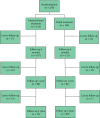Internet-based treatment of stress urinary incontinence: 1- and 2-year results of a randomized controlled trial with a focus on pelvic floor muscle training
- PMID: 25683075
- PMCID: PMC4690161
- DOI: 10.1111/bju.13091
Internet-based treatment of stress urinary incontinence: 1- and 2-year results of a randomized controlled trial with a focus on pelvic floor muscle training
Abstract
Objectives: To evaluate the long-term effects of two non-face-to-face treatment programmes for stress urinary incontinence (SUI) based on pelvic floor muscle training (PFMT).
Subjects and methods: The present study was a randomized controlled trial with online recruitment of 250 community-dwelling women aged 18-70 years with SUI ≥ one time/week. Diagnosis was based on validated self-assessed questionnaires, 2-day bladder diary and telephone interview with a urotherapist. Consecutive computer-generated block randomization was carried out with allocation by an independent administrator to 3 months of treatment with either an internet-based treatment programme (n = 124) or a programme sent by post (n = 126). Both interventions focused mainly on PFMT. The internet group received continuous e-mail support from a urotherapist, whereas the postal group trained on their own. Follow-up was performed after 1 and 2 years via self-assessed postal questionnaires. The primary outcomes were symptom severity (International Consultation on Incontinence Questionnaire Short Form [ICIQ-UI SF]) and condition-specific quality of life (ICIQ-Lower Urinary Tract Symptoms Quality of Life [ICIQ-LUTSqol]). Secondary outcomes were the Patient Global Impression of Improvement, health-specific quality of life (EQ-visual analogue scale [EQ-VAS]), use of incontinence aids, and satisfaction with treatment. There was no face-to-face contact with the participants at any time. Analysis was based on intention-to-treat.
Results: We lost 32.4% (81/250) of participants to follow-up after 1 year and 38.0% (95/250) after 2 years. With both interventions, we observed highly significant (P < 0.001) improvements with large effect sizes (>0.8) for symptoms and condition-specific quality of life (QoL) after 1 and 2 years, respectively. No significant differences were found between the groups. The mean (sd) changes in symptom score were 3.7 (3.3) for the internet group and 3.2 (3.4) for the postal group (P = 0.47) after 1 year, and 3.6 (3.5) for the internet group and 3.4 (3.3) for the postal group (P = 0.79) after 2 years. The mean changes (sd) in condition-specific QoL were 5.5 (6.5) for the internet group and 4.7 the for postal group (6.5) (P = 0.55) after 1 year, and 6.4 (6.0) for the internet group and 4.8 (7.6) for the postal group (P = 0.28) after 2 years. The proportions of participants perceiving they were much or very much improved were similar in both intervention groups after 1 year (internet, 31.9% [28/88]; postal, 33.8% [27/80], P = 0.82), but after 2 years significantly more participants in the internet group reported this degree of improvement (39.2% [29/74] vs 23.8% [19/80], P = 0.03). Health-specific QoL improved significantly in the internet group after 2 years (mean change in EQ-VAS, 3.8 [11.4], P = 0.005). We found no other significant improvements in this measure. At 1 year after treatment, 69.8% (60/86) of participants in the internet group and 60.5% (46/76) of participants in the postal group reported that they were still satisfied with the treatment result. After 2 years, the proportions were 64.9% (48/74) and 58.2% (46/79), respectively.
Conclusion: Non-face-to-face treatment of SUI with PFMT provides significant and clinically relevant improvements in symptoms and condition-specific QoL at 1 and 2 years after treatment.
Keywords: eHealth; long-term; pelvic floor muscle training; randomized controlled trial; self-management; stress urinary incontinence.
© 2015 The Authors BJU International published by John Wiley & Sons Ltd on behalf of BJU International.
Figures
References
-
- Haylen BT, de Ridder D, Freeman RM, et al. An International Urogynecological Association (IUGA)/International Continence Society (ICS) joint report on the terminology for female pelvic floor dysfunction. Neurourol Urodyn. 2010;29:4–20. - PubMed
-
- Milsom I, Altman D, Lapitan MC, Nelson R, Sillén U, Thom D. Epidemiology of urinary (UI) and faecal (FI) incontinence and pelvic organ prolapse (POP) In: Paul Abrams LC, Saad K, Alan W, editors. Incontinence, 4th International Consultation on Incontinence, Paris July 5–8, 2008 4th Edition 2009. Paris: Health Publication Ltd; 2009. pp. 35–113.
-
- Hannestad YS, Rortveit G, Sandvik H, Hunskaar S. A community-based epidemiological survey of female urinary incontinence: the Norwegian EPINCONT study. Epidemiology of incontinence in the County of Nord-Trondelag. J Clin Epidemiol. 2000;53:1150–7. - PubMed
-
- Shamliyan T, Wyman J, Kane RL. Nonsurgical Treatments for Urinary Incontinence in Adult Women: Diagnosis and Comparative Effectiveness. Rockville: Agency for Heathcare Research and Quality (US); 2012. [Internet] (Comparative Effectiveness Review No. 36). Available at: http://www.effectivehealthcare.ahrq.gov/ehc/products/169/834/urinary-inc.... Accessed November 2014. - PubMed
-
- Abrams P, Andersson KE, Birder L, et al. Fourth International Consultation on Incontinence Recommendations of the International Scientific Committee: evaluation and treatment of urinary incontinence, pelvic organ prolapse, and fecal incontinence. Neurourol Urodyn. 2010;29:213–40. - PubMed
Publication types
MeSH terms
LinkOut - more resources
Full Text Sources
Other Literature Sources
Medical




